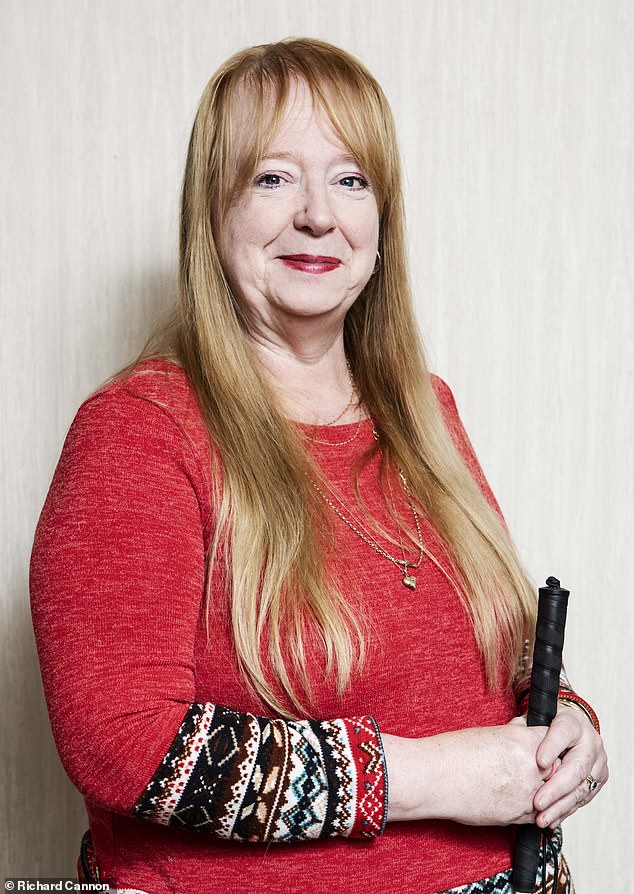The first time Louise Pilcher experienced one of the strange and disturbing visions that began to haunt her life was on an otherwise unremarkable midweek morning last summer.
The 62-year-old was relaxing with a cup of coffee at home when she glanced up and was terrified by the sight of a strange man standing close by, staring intently at her.
‘I was doing some crochet for a blanket I was making and looked up to see this man,’ says Louise, who lives in Deal, Kent, with her husband, Stephen, 57, who works in security.

Louise Pilcher, 62, was relaxing with a cup of coffee at home when she glanced up and was terrified by the sight of a strange man standing close by, staring intently at her
‘It made me jump. He was about five feet away from me and around 40 years old. He was smartly dressed in jeans and a jacket and was just staring silently down at me.
‘My heart began to race and I froze. The man didn’t show any emotion – just stared,’ she recalls.
Louise called out for Stephen, who came running.
‘I was trembling and said: “Please ask that person to leave.” And he said: “What person? There’s no one here.”
‘I turned back to the man – but he’d disappeared.’
Stephen did his best to calm his terrified wife, putting the incident down to her ‘imagining things’, as she says. ‘But I am a no-nonsense, practical person,’ says Louise, a former GP practice manager. ‘I was 100 per cent sure I had seen this man. I wondered if it had been a ghost but dismissed this because it wasn’t anyone I knew.
‘I thought I must be losing my mind,’ says Louise, who has no history of mental illness.
A week later she had another episode. Then another.
She recalls: ‘On one occasion, I was taking a shower and suddenly I was surrounded by fish, on the wall, swimming around. It was totally bizarre. They were brightly coloured – it was a very vivid image. I didn’t feel threatened, but it was scary.
‘Another time, I was sitting opposite my husband and a face appeared, floating behind him. It was the face of a bearded man; again someone I didn’t recognise. After a while it, too, disappeared.

‘They can be very vivid – one patient saw a leopard, another saw her ceiling on fire,’ says Dr Gow. ‘It’s not known why they see these particular images.’
‘On another occasion, I was watching a film and saw a giraffe lying across the top of our TV.
‘Stephen kept telling me to ring our GP. But I refused because I was embarrassed and terrified I was developing dementia or a mental health condition.
‘I became very stressed and anxious, constantly wondering what was going to happen next.’ The only recent change in Louise’s health had been a diagnosis a month before the first episode of macular oedema, a swelling in the retina of the eye which causes blurry vision – a complication of the type 2 diabetes she’d had for six years, detected at a regular eye screening appointment.
It wasn’t until six or so weeks after her first disturbing vision that Louise plucked up the courage to mention it to an eye care liaison officer (or ECLO, an NHS service) and learned there was a simple medical explanation, totally unrelated to mental health.
Counter-intuitively, her terrifying visions were actually rooted in her fading sight. Louise has Charles Bonnet syndrome (CBS) – vivid, silent, visual hallucinations caused by sight loss.
‘I’d never heard of it and no one warned me to expect this when I was diagnosed with macular oedema,’ says Louise. ‘I now know it’s a common feature of many types of sight loss.’
In fact, CBS affects up to 30 per cent of the two million people living with sight loss in the UK, according to optometrist Dr Louise Gow, head of eye health at the Royal National Institute of Blind People (RNIB).
This includes those with age-related macular degeneration, the leading cause of blindness in the UK, affecting an estimated 1.5million people, or diabetic eye disease or glaucoma (where the optic nerve becomes damaged).
Cataracts alone are not linked to CBS, although people with cataracts can experience hallucinations if they also have another sight-loss condition.
The numbers affected may actually be an underestimate, Dr Gow told Good Health, ‘because people are reluctant to report it as they fear they’re going mad or have dementia’.
Stress, tiredness and inactivity can all make hallucinations more likely in people with sight loss.
CBS is the name given to hallucinations specifically related to sight loss. A key feature is that the images never speak or make a noise.
‘They can be very vivid – one patient saw a leopard, another saw her ceiling on fire,’ says Dr Gow. ‘Many people report seeing military figures and people in period costume, such as Edwardian ladies in ruffled skirts. It’s not known why they see these particular images.’
She adds: ‘Some people like their hallucinations – a lonely older lady might find a cat image comforting, for instance. But sometimes they can be scary, such as witches, spiders, gargoyles and hair or worms in food. But it’s never someone you know and the image does not interact with you. These images also appear much clearer than the other things they can see — this is one way to tell that they are hallucinations.’
Although CBS hallucinations are more common in older people (due to loss of sight with age), they can affect any age group – although people blind from birth do not seem to experience them.
‘We don’t know the exact cause, but it is related to the way the brain processes data,’ says Dr Gow.
‘Visual information is sent to the brain via the optic nerve. But when this becomes damaged, messages and data can get disrupted. If information is lacking, the brain fills in the gaps – sometimes quite randomly.
‘People who have lost their sight do say it’s extraordinary to be able to see a perfect image. This is because even a damaged optic nerve transmits some light to the brain, so there is some information coming in which the brain tries to make sense of.’
But it can be a terrifying experience for patients and their loved ones, not least because CBS can often be confused with hallucinations caused by mental health conditions such as schizophrenia (which normally involves auditory hallucinations – hearing sounds or conversations, says Dr Victoria Chamorro, a consultant psychiatrist at Priory Hospital Roehampton, south-west London).
‘Many healthcare professionals do not know about CBS,’ says Dr Gow, ‘so we encourage all patients to suggest this as an option when talking to their GP so that they don’t go down the route of treating it as a psychiatric disorder or order unnecessary dementia tests.
‘The chances are that if they have any level of sight loss and the image is only visual, then it will be CBS.’
Simple techniques such as moving your head or standing up can make a hallucination disappear. ‘Or try to touch it – it will probably vanish,’ says Dr Gow.
This is thought to be because movement interrupts the corrupt signals to the brain. While there is no treatment, the visual hallucinations can sometimes spontaneously cease as abruptly as they began. This was true for Jeremy Johnston, a retired special needs teacher, who began seeing bizarre and vivid images eight months after a stroke.
Jeremy, 61, who lives in County Down in Northern Ireland with his wife, Alison, 58, also a retired teacher, lost the peripheral vision in the left-hand side of both eyes, but was otherwise recovering well.
‘Then I began seeing lights like a string of twinkling Christmas lights in the “blind spot” where I had lost my vision,’ he recalls.
‘I also had some other strange, fleeting experiences. Suddenly the TV would seem to zoom towards me off the wall, then retreat again to the size of a postage stamp. Once I was watching a cricket match, and the players’ heads seemed to be spinning on top of their shoulders as they ran past me.
‘A year after my stroke, I was in the kitchen cooking tea and chatting to our daughter, Rebecca, when her whole upper body bent backwards at her waist, and she touched her head on the ground behind her heels as she carried on chatting to me,’ Jeremy recalls.
‘I just thought: “This cannot be real,” and carried on cooking.
‘Fortunately, I always realised that they were not real images and I was determined to carry on as best I could.’

Jeremy Johnston, 61, a retired special needs teacher, began seeing bizarre and vivid images eight months after a stroke
Jeremy saw a neurologist privately, who diagnosed CBS linked to his stroke. Then the strange, ‘almost psychedelic’ images stopped as abruptly as they started in the summer of 2018 — lasting eight months in total. ‘I just hope they don’t return,’ says Jeremy.
Hallucinations and delusions (being convinced of something that isn’t true) affect one in 20 people who survive a stroke every year.
‘If there is damage to the occipital lobe of the brain, which deals with visual processing, this can cause hallucinations,’ explains psychologist Clare Jonas from the Stroke Association.
There are ‘no guarantees that hallucinations following a stroke will disappear for good, but it’s more likely if you’ve worked at the rehabilitation programme given by your stroke specialist’, she adds, as the brain effectively rewires itself around the damage.
Louise has helped to make training clips for the RNIB, ‘as it’s so important to know you are not alone’, she says.
She uses a range of techniques to help cope with her own hallucinations, including deep breathing and moving her position so the vision disappears. ‘Only a few days ago I saw a middle-aged woman I didn’t know wearing a hat,’ says Louise. ‘But I made sure that I followed the techniques I’ve learned and she disappeared — and it didn’t upset me at all.’
Other common causes of hallucinations
General anaesthetic: Patients who’ve had a general anaesthetic in the form of benzodiazepines and anticholinergics may experience confusion, leading to hallucinations, says Dr Helgi Johannsson, vice-president of the Royal College of Anaesthetists.
Post-operative delirium, as it’s known, is ‘quite common’; a combination of the drugs, plus the trauma of surgery (which prompts the release of hormones that cause inflammation, including in the brain), pain and lack of sleep, all combine to temporarily ‘scramble the brain’.
‘For some it can be very disturbing, particularly for older patients,’ says Dr Johannsson, a consultant anaesthetist at Imperial College Healthcare NHS Trust in London. ‘I once had a patient, a World War II veteran in his 80s, who came round from his anaesthetic and became violent towards me — and he was very strong — because he was convinced I was a Nazi soldier. The next day he remembered nothing about it and was nice as pie.’
Painkillers and tranquilisers: Medications including painkilling opioids (such as morphine) can also trigger hallucinations. These work by binding to the brain’s opioid receptors, which relieves pain but can lead to hallucinations.
Tranquilisers including benzodiazepines (such as Valium), used to treat epilepsy and anxiety, can raise the risk of visual and auditory hallucinations.
‘It’s believed this is because the body perceives it is being artificially calmed and tries to rectify it by becoming more excited, including producing images and sounds that aren’t there,’ says Nahim Khan, a lecturer in pharmacology at the University of Chester.
Parkinson’s and dementia: Hallucinations, or delusions, are a lesser-known symptom of Parkinson’s disease, affecting up to 40 per cent of the 145,000 people in the UK with the disease, particularly in its later stages.
Seeing things that aren’t there – typically people and animals – also happens to 70-80 per cent of people who have dementia with Lewy bodies, says Professor Rimona Weil, a consultant neurologist at the National Hospital for Neurology and Neurosurgery in London. ‘These hallucinations can seem very real and often happen at the same time of day and in the same place,’ she explains.
Hallucinations in people with Parkinson’s can occur regardless of whether they also have major problems with their sight, she adds — due to the effect of the disease itself on certain brain chemicals, and drug treatments. The disease leads to low levels of dopamine, important for movement. Patients are given dopamine in the form of the drug, levodopa. ‘But we can’t target specific areas of the brain’, explains Nahim Khan, ‘which results in an excess in other parts, specifically the mesolimbic region, involved in perception and reality.’
Some people ‘smell’ things that aren’t actually there. Known as phantosmia or olfactory hallucinations, the odours may be pleasant or foul. Causes include head injury or respiratory infection, but it can also be the result of brain tumours, psychiatric disorders such as bipolar, plus dementia and Parkinson’s.




